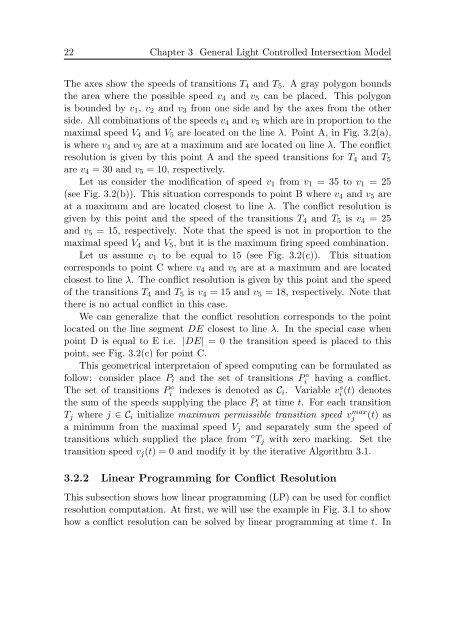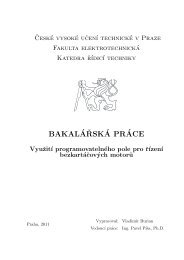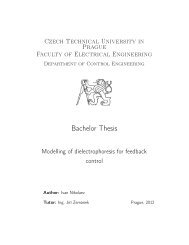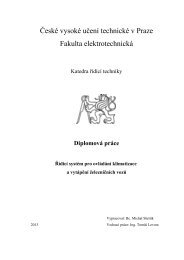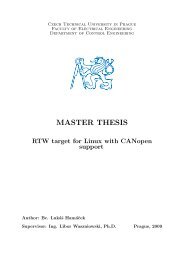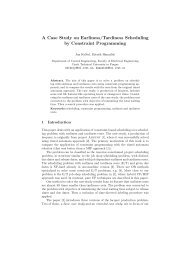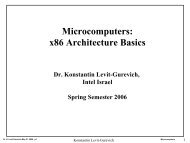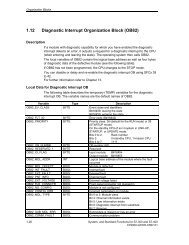Modeling and Optimization of Traffic Flow in Urban Areas - Czech ...
Modeling and Optimization of Traffic Flow in Urban Areas - Czech ...
Modeling and Optimization of Traffic Flow in Urban Areas - Czech ...
Create successful ePaper yourself
Turn your PDF publications into a flip-book with our unique Google optimized e-Paper software.
22 Chapter 3 General Light Controlled Intersection ModelThe axes show the speeds <strong>of</strong> transitions T 4 <strong>and</strong> T 5 . A gray polygon boundsthe area where the possible speed v 4 <strong>and</strong> v 5 can be placed. This polygonis bounded by v 1 , v 2 <strong>and</strong> v 3 from one side <strong>and</strong> by the axes from the otherside. All comb<strong>in</strong>ations <strong>of</strong> the speeds v 4 <strong>and</strong> v 5 which are <strong>in</strong> proportion to themaximal speed V 4 <strong>and</strong> V 5 are located on the l<strong>in</strong>e λ. Po<strong>in</strong>t A, <strong>in</strong> Fig. 3.2(a),is where v 4 <strong>and</strong> v 5 are at a maximum <strong>and</strong> are located on l<strong>in</strong>e λ. The conflictresolution is given by this po<strong>in</strong>t A <strong>and</strong> the speed transitions for T 4 <strong>and</strong> T 5are v 4 = 30 <strong>and</strong> v 5 = 10, respectively.Let us consider the modification <strong>of</strong> speed v 1 from v 1 = 35 to v 1 = 25(see Fig. 3.2(b)). This situation corresponds to po<strong>in</strong>t B where v 4 <strong>and</strong> v 5 areat a maximum <strong>and</strong> are located closest to l<strong>in</strong>e λ. The conflict resolution isgiven by this po<strong>in</strong>t <strong>and</strong> the speed <strong>of</strong> the transitions T 4 <strong>and</strong> T 5 is v 4 = 25<strong>and</strong> v 5 = 15, respectively. Note that the speed is not <strong>in</strong> proportion to themaximal speed V 4 <strong>and</strong> V 5 , but it is the maximum fir<strong>in</strong>g speed comb<strong>in</strong>ation.Let us assume v 1 to be equal to 15 (see Fig. 3.2(c)). This situationcorresponds to po<strong>in</strong>t C where v 4 <strong>and</strong> v 5 are at a maximum <strong>and</strong> are locatedclosest to l<strong>in</strong>e λ. The conflict resolution is given by this po<strong>in</strong>t <strong>and</strong> the speed<strong>of</strong> the transitions T 4 <strong>and</strong> T 5 is v 4 = 15 <strong>and</strong> v 5 = 18, respectively. Note thatthere is no actual conflict <strong>in</strong> this case.We can generalize that the conflict resolution corresponds to the po<strong>in</strong>tlocated on the l<strong>in</strong>e segment DE closest to l<strong>in</strong>e λ. In the special case whenpo<strong>in</strong>t D is equal to E i.e. |DE| = 0 the transition speed is placed to thispo<strong>in</strong>t, see Fig. 3.2(c) for po<strong>in</strong>t C.This geometrical <strong>in</strong>terpretaion <strong>of</strong> speed comput<strong>in</strong>g can be formulated asfollow: consider place P i <strong>and</strong> the set <strong>of</strong> transitions Pi◦ hav<strong>in</strong>g a conflict.The set <strong>of</strong> transitions Pi◦ <strong>in</strong>dexes is denoted as C i . Variable vi s (t) denotesthe sum <strong>of</strong> the speeds supply<strong>in</strong>g the place P i at time t. For each transitionT j where j ∈ C i <strong>in</strong>itialize maximum permissible transition speed vjmax (t) asa m<strong>in</strong>imum from the maximal speed V j <strong>and</strong> separately sum the speed <strong>of</strong>transitions which supplied the place from ◦ T j with zero mark<strong>in</strong>g. Set thetransition speed v j (t) = 0 <strong>and</strong> modify it by the iterative Algorithm 3.1.3.2.2 L<strong>in</strong>ear Programm<strong>in</strong>g for Conflict ResolutionThis subsection shows how l<strong>in</strong>ear programm<strong>in</strong>g (LP) can be used for conflictresolution computation. At first, we will use the example <strong>in</strong> Fig. 3.1 to showhow a conflict resolution can be solved by l<strong>in</strong>ear programm<strong>in</strong>g at time t. In


